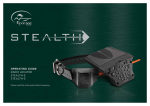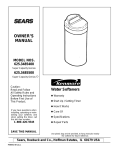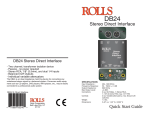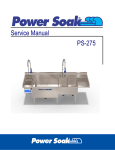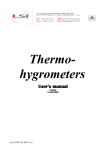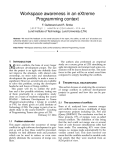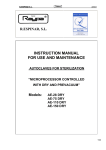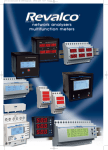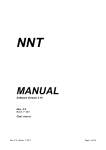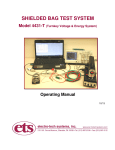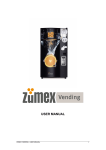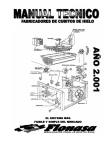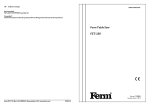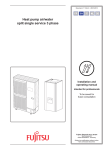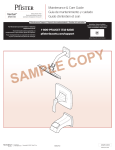Download Untitled
Transcript
INDEX Technical Specifications: - Function Limitations …….. ............................................................. 1 - Production capacity……… ............................................................. 1 - Dimensions .................................................................................... 2 - General Features ........................................................................... 2 General information and installation: Process of adjusting, elimination and substitution of components…............................................................................. 14 Electrical diagram ..................................................................... 19 Troubleshooting … .................................................................... 20 Diagnosis service....................................................................... 21 - Introduction .................................................................................... 3 - Unpackaging and inspection........................................................... 3 Cleaning and maintenance instructions - Location and levelling….................................................................. 4 - General ........................................................................................ 22 - Electrical connection ...................................................................... 4 - Cleaning the ice making equipment……...................................... 22 - Drain and water connexions.. ........................................................ 4 - Instructions for cleaning the water circuit………… ...................... 23 Operation instructions Control Panel ……..................................................................... 25 - Start-up…………….......................................................................... 5 - Verifying operation with the equipment working………………........ 5 Operation principle - Water circuit….. ............................................................................. 7 - Cooling circuit…… ........................................................................ 8 - Components description……. ...................................................... 11 Components of Ice making equipment…............................. 26 Type of installation - Installation in an adjacent room… ............................................... 28 - Installation in a false ceiling….. ................................................... 29 - Ice fountain semiannual maintenance….. .................................. 30 TECHNICAL SPECIFICATIONS ¾ PRODUCTION CAPACITY MODULAR ELECTRONIC ICE EQUIPMENT mod. GEL-MF 30 ¾ OPERATION LIMITS Environmental temperature Water temperature Water pressure Variation with regard to plate tension MIN MAX 10º C 40º C 5º C 35º C 1 bar 5 bares -10% 10% NOTE: The daily production capacity change when the environmental temperature and the water supply change, a capacidad de producción diaria varía al variar la temperatura ambiente y del agua de alimentación , thus the space around the equipment.. So as to mantain the equipment in maximum efficient conditions, it is necessary to do the periodic maintenance as explained in the correspondence part of the manual 1 ¾ DIMENSIONS OF THE EQUIPMENT ¾ MF – 30 GENERAL FEATURES Model MF 30 AS MF 30 WS Cooling Air Water Material Stainless Steel Compr. CV 3/4 3/4 Water consumption (l/24 HR) 200 850 * * To 15º C of water temperature Tension 230 / 50 / 1 2 Amperes 4 Ampere Start-up 20 Power 760 W Electrical cons. Cable Kw h by 24 HR Section 17 3 x 1 mm 2 Fuse Amperes 10 High (Whitout base) High (with base) Wide Deep Weight 525 mm 542 mm 560 mm 533 mm 49 Kg. INSTALLATION AND GENERAL INFORMATION ¾ INTRODUCTION ¾ This operation manual has been writing to give the technical specifications as well as all the instalation instructions, start-up, operation, maintenance and cleaning the modular equipment of ice crusher and super ice crusher of MF electronic range. The electronic equipment of ice crusher and super ice crusher has been designed and manufactured with high quality level. The equipment is tested during several hours and reassure a maximum performance in whatever use and situation. 2. Check the external cartoon packaging and the wood platform used for the delivery. Whatever obvious damage in the external packaging has to be notify to the transport; in this case check the equipment with a representative of the transport agency. 3. a) Cut and take out the plastic ribbons that mantain seale the cartoon packaging. b) Take out the cramps that fix the cartoon in the platform. c) Open the upper side of the packaging and take out the V protective angular plate d) Lift the cartoon taking it out of the equipment. 4. In models MF 22, MF 30, MF 41 Y MF 51 take out frontal panel / saque el frontal / top panel , while in model MF 61 take out top and lateral panels and check the unit so as to verify it has not been damage during transport. NOTA: It is recommended when making the installation and the maintenance operation, follow this manual so as not to damage or reduce the quality and security characteristics of the equipment. 5. Take out the inner supports used for the transport as well as adhesive ribbons. - Store of ice 7. Check the compressor it is free of swing above their own shock absorbers.. The equipment model MF do not have pile ice dispenser basin, thus it is necessary to design and build one with the material most suitable according the the decoration of the room. Having into account the following points: The high of the basin has to be between 90 and 100 cm to make easy the pick up of the ice. 6. Check the pipe of the cooling circuit do not graze between them and it do not touch other pipes or surfaces; make sure the fan spin freely. 8. Observe the details of the plate located in the back part of the frame near the water and electrical connexions and check that the voltage of the electric net it is suitable for the equipment. The dimensions of the ice dispenser has to be approximately of 60 cm wide x60 cm deep x20 cm high. ATTENTION: A wrong voltage of electric supply will cancel automatically the warranty. It has to have a drain to throw away the ice. 9. Fill in the warranty coupon located inside the User manual, refer to the model and the serial number of the unit located in the plate fixed to the frame. Send the coupon to your local distributor. ¾ UNPACKAGING AND INSPECTION - Ice equipment 1. Ask the assistance of the official distributor for a correct installation. 3 ¾ LOCATION AND LEVELLING ATTENTION: this ice equipment has been designed to be installed in areas where the room temperature do no exceed the maximum of 40 º C nor the minimum of 10 º C Prolonged period of operation with temperature different ot the mentioned represents a wrong use of the equipment and suppose the nullity of the guarantee. ¾ ELECTRICAL CONNEXIONS To choose the kind and section of the cable observe the ampère indicated in the plate of the equipment. All the equipments has an electric supply cable, so it is needed a conection to the electric line equipped with earth cable and with magnetothermic switch with fuse appropriate as it is indicated in the plate of each equipment. The maximum ampere variation permitted does not have to exceed a 10% of the plate or be less than a 10% of the same. A lower ampère can produce an anomalous operation and make damage seriously the protection device and the electric winding. Water is the most simple and important ingredient for making ice, for this resason the previous points are very important. A low pressure of water, below 1 bar can origin problem with the operation of the unit. Water that contains and excess of minerals can produce a residuum sheet in the inner parts of the water system, meanwhile a soft water containing lower mineral salts produce a granular ice too “dry”. ATTENTION: Using soft water (lower mineral salt) with less electric conductivity of 30 mS don’t let the low tension electricity to go through between the sensors of water level, causing the stop or wrong function of the unit. Chlorine water or ironish water can be partially improve with active coal filters. - Inlet of water Connect the male connector to the water inlet of 3/4" Gas to the water line using a reinforced plastic pipe with non-polsonous material for food or a copper pie with external diameter of 3/8". NOTE: All the external connexions has to be perfect, according with the local laws. In some cases it is needed the intervention of a qualified electrician.. The inlet water line has to have a stopcock located in an accessible place near the unit. If water has a high level of impirites it is recommended to install a fitler or a purifier to prepare it appropriately. Before connecting the ice equipment with the electric line, check the ampère again of the unit, detail in the plate, with the correspondent ampère of the electric supply. - Water inlet – Water cooling models The models cooled with water need two separate inlet lines; one for the tank and the other one has to go through one adjustment mechanic valve to the cooling condenser. ¾ WATER AND DRAIN CONNEXION - General When choosing the water line for the modular crush and supercrush ice equipment of model MF take care of the following: la serie MF, a) Length of the line b) Clear and pure water c) Suitable pressure of the line. 4 Also for the water connection of the condenser use a reinforced plastic flexible pipe or a copper pipe of 3/ 8 with female connector of+" Gas and a separet bypass valve. - Drain It is recommended a rigid plastic pipe with internal diameter of 18 mm and constant flow of 3 cm per meter. The draining of remainder water it is made by gravity; it is necessary a drianing with vertical air inlet near the connector and that it go to the open siphon for a constant flow. - Drain – Model cooled with water C. After the compressor work 2 or 3 minutes, check that the ice go out through the unloading hole and through the pipe go to the store. NOTE. The first ice granule present a scarce consistence because the temperature of evaporation still have to reach the normal functioning value. Wait 10 minutes so as the evaporation temperature go down to the normal functioning values so as the ice has the correct consistence. The equipment cooled with water need a new line of drain separet with a male connector 3/4" Gas that comes with the indication “Drain- Only for cooled with water". NOTE: All the water connections has to be perfect and realise according to the local laws. In some cases it is necessary the intervention of a qualified plumber. NOTE. If after 10 minutes of being working the equipment the temperature of the evaporator has not reach below 1°C due to an inadequate quantity of cooler, the temperature sensor of the evaporator detects this abnormal situation and consequently stop the unit. In this circumstance, the YELLOW LIGHT switch on. OPERATION INSTRUCTIONS ¾ After diagnosing and eliminating the problem of this poor evaporation temperature due to inadequate quantity of cooler or excessive condensation temperature, press the boton RESET located in the lid of the control STARTING After a correct electrical, water and drain installation, follow the next instructions for the starting up: After 3 minutes, with the RED LIGHT flashing, the unit will start working. A. Open the tap and connect the plug or electric general switch located in the electrical connexion line. The first GREEN LIGHT will light, showing the unit is under tension. ¾ NOTE: When the unit has been some time disconnected, the RED LIGHT it is flashing during 3 minutes; afther these minutes it will start the motor ot the gear reduction and after 5 seconds the compresor. CHECKING THE PERFORMANCE WITH THE UNIT WORKING D. Take out the front panel and if it is needed put the high and low pressure gauge in their corresponding tyre valve to check the condensation and air intake pressure. B. After the 3 minutes, the unit will start up activating the following components: - MOTOR / S REDUCTION GEAR COMPRESSOR - MOTOR / S OF FAN(if the unit is cooling with air), controled by the temperature sensor of the condenser located in the wings of the same. 5 NOTE: in the air cooled models, the condensation pressure remain between two values preestablished throught the fan, sending intermittently through the sensor located in the wings’ condenser. If the condensation temperature reach to 70 º C due to and obstruction in the condenser and/or the motor of the fan do not work, the sensor temperature of the condenser stop the unit and consequently a RED LIGHT of danger is switch on. F. Check the correct function of ice level control electronic eyes, put the hand between the two sensor located in the outlet pipe. (one in every pipe in model MF61). In this way it is interrumped the beam and switch off the RED LIGHT located in the front side of the electroic Card. After 6 second the unit stops automatically and switch On the YELLOW LIGHT showing the situation FULL CABIN. The beam of light is retablished after 6 seconds, the unit will start up Automatically (after de 3 minutes of delay) and the yellow Light that has been switched on before. After diagnosing and solving the problem, repit the operation indicated in the previous “Note” to start up again the unit. E. Check the correct functioning of the water level sensor, close the stopcock. After some minutes when the level of water Go down the sensor, the unit will stop and inmediately switch on the YELLOW LIGHT showing the lack of water. NOTE: The water level sensor detects the presence of inadequate quantity of water in the tank and it confirms it to the microprocessor manintining an electric low ampère flow through the sensors using the water as a conductive material. ATTENTION. To use demineralize water (water whitout or with little salt) with a electric conductivity of less than 30 mS not allow the lower tension electricity to pass making the unit to stop or not functioning, a YELLOW LIGHT swith one showing a lack of water. After open again the stopcock, the YELLOW LIGHT switch off automatically and a RED LIGHT is flashing. After 3 minutes the unit start up again, first the reduction gear and after 5 seconds the compresor. 6 NOTE. The control level of the ice (infrared system) is independent of the temperature, otherwise it can be affected for the external light and the dirty or lime deposits located directly in the eyes(infrared sensors). For a correct operation of the unit it necessary to install it far away of direct point of light and to scrupulously observe the points mentioned in the maintenance of the eyesde los ojos. G. If they are instaled take out the auxiliar manometers and install again the frontal panel that have been taken before. H. Explain to the owner the function of the ice equipment as well as the cleaning and maintenance of the same. PRINCIPLE OF OPERATION ¾ WATER CIRCUIT Water enter into the machine by the inlet line, where there is a small arille filer located in the back side and here reach the wáter tank going through a float valve. NOTE: The presence of water in the tank is detected by a system of two sensors that work together with the electronic board. Both sensors use the water as a conductive to maintain a electric flow of low voltage that it is send to the electronic board showing the presence of water in the tank. The lack of water or the presence of soft water with an electrical conductivity with less of 30mS (demineralize waters)means the interruption of electrical flow to the electronic boards and consequently the stop of the unit and the switch on of the YELLOW LIGHT of ” lack of water”. Tank of wáter is located allied of the evaporator case to a high that allows through the communicative pipes, maintain constantly a correct level of wáter inside the evaporator case. Water enters from the tank through the conexion pipe inside the evaporator case, where it is unfreeze and it is transformed in ice; this is constantly mantained in movement by a stainless steel shaft that turn inside the evaporator case. The shaft, sumerge in water inside the evaporator turn in antitimetable direction by the action of a reductive motor, pushing up the sheet of ice that is formed in the internal cooled walls of the evaportor. The ice, when it is push up by the shaft becomes more thick and when it reach the crush it is compacted and cut into pieces, going through the outlet pipe and falling into the ice keeper. When the unit start up, it start up the continuous process of ice making, process that continue until the ice keeper is full until the level sensors located in the pipe of outlet ice. When the ice interrumps the infrared beam of light between both electronic eyes ( one or both in the model MF 61), the unit stops, the YELLOW LIGHT switch on that shows the situation of full cabin. 7 The liquid circuit lead the refrigerant from the condenser to the capillary tube through a dehydrated filter. When the refrigerant in liquid state goes through the capillary tube lose gradually a part of pressure and a part of temperature. Then it reachs and enter in the coil evaporator. Water in contact with the cooled walls of the evaporator give heat to the refrigerant that flow inside the coil, making its evaporation and the consequent change of liquid state into steam. The regrigerant in steam state after going through the accumulator it is suck in again in the compressor trhough the aspiration line. NOTE: The interruption of the beam between the sensors is inmediately showed by the switch off of the RED LIGHT located in the electronic board. Afther the interrumption of the beam of light during 6 seconds, the unit stops and the YELLOW LIGHT switch on. The 6 seconds of delay protect the unit of unnecessary stops due to the eventual interruption of the beam of light, that can be produced for the fall of the ice through the pipe. When the ice is taken out of the store cabin and the outlet pipe get free, the beam of light between the two sensors is inmediately reestablished and the RED LIGHT is switch on in the centre of the board. After 6 seconds the unit start up again, the YELLOW LIGHT of full cabin switch off and after 2-3 seconds the ice fall again through the pipe. ¾ COOLING CIRCUIT The refrigerant in gaseous state and high temperature it is pumped from the compressor, going through the condenser and it is transformed in regrigerant in liquid state. 8 The pressure of push of the refrigerant system (high pressure) it is mantained between the previously establish values (8/9 bar for MF 22 and 17/18 bar for MF30, MF 41, MF 51 Y MF 61) through the temperature sensor of the condenser that has the probe located inside the sheet of the condenser, in the air cooled models. This sensor notice the increase of temperature in the condenser above the established limit, change its electric resistance and send low tension electricity to the MICROPROCESSOR of the electronic board that supply through a triac the fan motor in intermittend way ON – OFF. In water cooled models, the high pressure of the system is constant to 8.5 bar in model MF 22, and to 17 bar in models MF 30, MF 41, MF 51 Y MF 61, due to a quantity of water that goes through the condenser, which flow is controled by the action of the presostate valve that it is open to increase the water flow that cool the condenser. 9 NOTE, In case the temperature sensor of the condenser detects 70ac ' in the cooled air model or 62º Cin the water cooled version for one of these reasons: Capillary pipe COOLING EXPANSION DEVISE: PRESSURE OF OPERATION (With a room temperature of 21º) - DIRTLY CONDENSER (cooled by air) - INADEQUATE CONDENSATION WATER (cooled by water) - BURNT FAN OR STOPPED (cooled by air) - HIGH ROOM TEMPERATURE (UP TO 43° C) Pressure of impuls: Cooling by air Cooling by water MF - 22 8 / 9 bar 8,5 bar MF 30 - 41 - 51 - 61 17 / 18 bar 17 bar Pressure of air intake: 0,5 bar 2.5 bar the unit stop inmediately so as to prevent to be working in extremely abnormal and dangerous situation. When this happens it switch on the RED LIGHT,that warn of high temperature. After eliminating the cause of excessive temperature in the condenser, push button RE-SET. The RED LIGHT will flash and after 3 minutes the unit will start working. The temperature sensor of the condenser has also another option for security, it consist in preventing the start up of the unit if the room temperature (detected by the sensor of the condenser) in where it is installed the unit is less than 10 C. When the room temperature is up to 10º C, the electronic board start up again the unit automatically after 3 minutes. The pressure of air intake or low pressure in normal conditions is of 0.5 bar in model MF 22 and 2.4+2.6 bar in model MF 31, MF 41, MF 51 Y MF 61 after some minutes of operation. These valuer can change between 0.1 bar or 1.2 bar, in relation with the water temperature that supply the evaporator. COOLING CHARGE (R 134 A) MF 22 Cooling by air Cooling by water 440 g 380 g COOLING CHARGE (R 404 A) Cooling by air Cooling by water MF 30 540 g 410 g MF 41 750 g 600 g MF 51 880 g 820 g MF 61 2200 g 1300 g NOTE If after 10 minutes of operation not produce ice and the tempertaure registered by the sensors of the evaporator do not reach -1 C, the unit stops and switch on flashing the 5th YELLOW LIGHT NOTE: Before charging the refrigerator system, check the technical data of the identification plate of the unit for the kind of indentification of the equipment as well as the kind of refrigerant and the quantity 10 ¾ DESCRIPTION OF COMPONENTS A. TEMPERATURE SENSOR OF THE EVAPORATOR The sensor of temperature of the evaporator, located inside a bulb pipe, it is welded in the outlet of the freezer tube, register the temperature of the refrigerant aspirated transmitting a signal (low tension electricity) to the microprocessor. Depending on the signal received, the microprocessor give green light to the ice equipment to continue working (evaporation temperature below -1°C after 10 minutes working or in case there is a lack partially or totally of refrigerant in the system, stops the equipment flashing the 5a YELLOW LIGHT (evaporation temperature above -1°C after 10 minutes of operation). B. SENSOR OF WATER LEVEL FLOAT TANK The sensor of water level of the flowt tank it is composed of two stainless steel sensors vertically anchored to the lid and connected electrically to the low tension circuitry of the electronic board. Its lower extreme is sumerged in the water tank and throught a current of flow that it is transmitted through the mineral salt of the water, mark its presence to the electronic board. In the models cooled by air, the probe of the condenser control also the operation of the fan motor through a MICROPROCESSOR of the electronic board. Using the TRIAC, tjos start up the motor of the fan removing the heat of the condenser and consequently lowing the temperature. If the temperature of the condenser is above 62°C to 70°C depending on the position of the microswitch number 8, the signal that arrives to the MICROPROCESSOR make to stop the unit. NOTE. So as the unit start up again, push the button REARM (after solving the cause that has produce the stop) or unplug and plug again the unit. D. SPEED SENSOR AND DIRECTION OF MOTOR IN THE REDUCTION GEAR (Two in models MF 61) The sensor of speed and the direction of rotation of the motor in the reduction gear (one for each motor in model MF 61). Register through a magnetic signal (effect hall) the speed and direction of rotation of the motor. When it is below 1300 revolutions by minute, the signal transmitted to the MICROPROCESSOR of the electronic board stop inmediately the unit and it switch on a YELLOW LIGHT. The same happens when the motor run in the incorrect direction avoinding that the ice inside the evaportor make a unic body with the axis. NOTE. The lack of water or the presence of water whitout mineral salt (electrical conductivity below 30 mS)means the interruption or reduction of the electric current transmitted to the electronic board, with the consequent stop of the unit, show with the switch on of the YELLOW LIGHT. C. SENSOR OF TEMPERATURE OF THE CONDENSER NOTE. To start up the unit in both cases ( slow don and attempt opposing rotation) push button rearm (after solving the cause that has produced the stop) or the switch and the electrical connexion. The sensor of temperature of the condenser (located between the wings of the air condenser or in contact with its coil in the case of water condenser) registers the temperature of condensation and transmitt the variations sending a signal to the electronic board. In case the temperature of sensor of the condenser have a value below +3°C (room temperature too low), the electronic board don’t start up the unit the temperature of the probe gets to +10°C. 11 E. OPTICAL SYSTEM OF ICE LEVEL CONTROL (Two in the models MF 61) The optical system to control the level of ice (one for each discharge pipe in model MF 61), installed inside the ice discharge pipe, stop the unit when the level of ice interrumpt the beam of light(by infrared) transmitted between the two electronic eyes. When the beam of light stop, the RED LIGHT in the centre of the electronic board switch off; the continuos stop of the beam of light during more than 10 seconds stop completly the unit switching on the second YELLOW LIGHT. The 10 seconds of delay for the stop of the unit prevent that the unit stops by a chance and undesired interrumption of the beam of light (pieces of ice that fall for the discharge pipe) En cuanto se quita el hielo para que el haz de luz pueda volver a pasar entre los ojos electrónicos, la LUZ ROJA vuelve a encenderse inmediatamente arrancando, después de 10 GREEN LIGHT: Low tension unit / operation YELLOW LIGHT: Unit stop storage full YELLOW LIGHT: Unit stop low level of water in the tank F. ELECTRONIC BOARD The electronic board, located in a plastic box fix in the front part of the unit, consists of two separate printed circuit, one of high voltage and the other one of low voltage, protected by three fuses, integrated it by a button RE-SET (REARM). There are also 5 lights indicating the operation of the unit, one extra RED LIGHT , 8 DIP SWITCH of switching inlet and some connection terminals with the inlet peripherals (sensors) and outlet peripherals (electric components). The electronic board is the brain of the system and process through the microprocessor, the signals received by the sensors to control the functioning ot all the electric components of the unit (compresor, reduction gear, etc). The five LIGHTS in the front of the electronic board show the following situations: RED LIGHT FLASHING: 3 minutes of delay RED LIGHT FIX: Unit stop for high temperature of condensation Unit stop for room temperature below 3ºC YELLOW LIGHT FIX: Unit stop rotation in the opposite direction of The motor in the reduction gear Unit stop for speed of rotation of the motor, Reduction gear too low YELLOW LIGHT FLASHING Unit stop for high temperature of evaporation above – 1º C after 10 minutes of working 12 G. TANK FOR THE FLOAT J. REDUCTION MOTOR (two in model MF 61) The tank has a plastic box with a float with screw of adjustment in the top that mantains a constant level of water in the tank and with communicating vessels inside the evaporator. In the lid there are two sensors to control the level of water that signs to the electronic board the presence of water in the tank. It has an asynchrounous one-phase motor with a condenser installed in reduction gear box of gears and pinions, the reduction motor activate through a transmission connection the axis of elevation of ice located inside the vertical evaporator. The rotation of the motor, subjected by two ball bearing of permanent lubrication, transmit the movement to a fibre gear (to reduce the fluid) of it, with a pair of gears and pinions subjected by the roller gears located in the upper and lower extreme of the outlet axis. The reduction gear is seal, by the presence of thw retainers installed in the hole of rotor axis and outlet axis and it is lubricated with specific grease (MOBILPREX IP 44). NOTE. It is very important to place correctly the lid in the tank of the float, so as to the sensors be submerged and can transmit an electrical signal that confirms to the electronic board the presence of water in the tank and avoid inopportune stop of the ice equipment. K. MOTOR OF THE FAN (Models cooled by air) H. EVAPORATOR (Two in model MF 61) The evaporator has a stainless steel vertical pipe in which external side it is solded the evaporation chamber of the refrigerant and in which in the interior there is the axis that turns and it is mantained in axis by the action of the top and lower treads. In the lower part of the evaporator there is a retention ring that hermetically seals it, while in the top part there is the ice crusher machine. The motor of the fan is comanded through the TRIAC of the electronic board, by the sensor of temperature of the condenser. It works making to flow the air thorugh the sheets of the condenser. In conditions with a low room temperature, it can intermittently work to maintain the condensation temperature between the pressetablished values. L. PRESOSTATIC VALVE (Model cooled by water) I. CRUSHING RING OF ICE (Two in model MF 61) The crushing ring of ice is on the top side of the evaporator and it has in models MF 22-30, two cogs to crush the ice; with its inclined shape (the back cogs to front) compress and force the ice to come out in horizontal direction. In the other models, the ice crusher equipment has some rectangular holes through the ones the ice is compressed. In this way, the ice loses the excess of water and fall to the storage in compact and dried grains. In the crush ice machine there is a top tread, and it has two stainless steel rolling crowns located in a way that can support the axial and radial load of the axis. NOTE: It is recommended to check every 6 months the state of the lubricant as well as the upper tread. The presostatic valve mantains a contant value of high pressure in the cooling circuit changing the water flow in the condenser. When the pressure increase the presostatic valve interiorily opens to increase the flow of water in the condenser. M. COMPRESOR The hermetic compresor is the heart of the system and it makes the refrigerant to circulate in the refrigerator. It intakes the refrigerant as a low pressure and low temperature steam and it transforms it as high pressure and high temperature steam, sending it to the circuit through the discharge or high valve. 13 PROCESS OF ADJUSTMENT, REMOVAL AND SUBSTITUTION OF THE COMPONENTS NOTE: Reas carefully the following instructions before make a substitution or adjustment process. 2. To drop the level of water make the same as before but putting down the tank. ATTENTION. Before doing this regulation makes sure that the problem is the level of water (check troubleshooting). Make sure the electric supply is disconnected and the stopcock of water close so as to prevent damages. A. ADJUSTMENT THE WATER LEVEL IN THE EVAPORATOR The correct level in the evaporator is 25mm below the outlet ice hole (discharge hole). A lower level of water can cause a major rubing of the ice and of the axis due to a quickly freese of water. B. SUBSTITUTION OF THE SENSOR OF TEMPERATURE OF THE EVAPORATOR 1.Take out the fornatl /upper panel. 2. Take out the isolation of pipes that connect the evaporator with the storage heater to accede the bulb tub weld in the pipe of the cooling pipe outlet and take out the inner sensor of temperature. 3. Look for the connection of the evaporator’s sensor in the back side of the electric box and disengage it making prise with the anchored tab. 4. To install again the sensor of the evaporator follow this process on the other way round. C. SUBSTITUTION OF THE SENSOR OF TEMPERATURE OF THE CONDENSER When the level of water is above or below than the normal level, the regulation consists in raising and droping the level of water moving up or down the tank 1 To raise the level of water act as following: - - 14 a)Take out the screw that fix the support of water tank and raise it all the necessary until it reach the level required. b ) Put the screw in the correspondent drill holes and tighten it. 1. Take out the frontal / upper panel and in model MF61 take out also the right side panel. 2. Look for the sensible bulb of the condenser sensor placed between its wings and in the models cooled by air and take it out. In models cooled by water take the bulb out after open the plastic bracket (it can be used again) that fix it to the pipe of the liquid. 3. Look for the connection of the sensor of the evaporator in the back side of the electric box and disengage it making prise with the anchored tab. 4. To install again the sensor of the evaporator follow this process on the other way round. D. SUBSTITUTION OF OPTICAL CONTROL OF LEVEL OF ICE F. SUBSTITUTION OF SENSOR OF WATER LEVEL IN THE TANK 1. Take out the upper /frontal panel in models MF 22, MF 30, MF 41 Y MF 51 and take out the frontal/ back panel in model MF 61. 1. Take out the frontal/upper panel. 2. Look for in the back side of the electric box the optical control conexión of level of ice with 4 plugs of white colour and disengage it from its place making prise with rubber anchored tab. 3. Take out the two electric eyes of its light port take them out of the drills located in the two opposite side of the outlet discharge hole, making pressure in the external part of the rubber elements, take attention so as not to damage the sensible side (infrared reader) 4.To install again the optical control of ice level follow this instructions on the other way round. 2. Unscrew the anchore nuts from the connection of cables of both stainless steel bars –sensor of level of water-located in the float tank. 3. Look for in the back side of the electric box the connection of the sensor of level of water from two red plugs and disengage it from its place making prise with the anchored tab. 4. To install the new sensor of level of water follow this instructions on the other way round. G. SUBSTITUTION OF THE ELECTRONIC BOARD 1. Take out the frontal/upper panel. E. SUBSTITUTION OF CORRECT SENSOR OF ROTATION IN THE MOTOR (HALL EFFECT) 1.Take out upper/frontal and side/back panel in models MF22, MF30, MF41 and MF51, while in model MF61 take out the left side/upper panel.. 2. Unscrew the screws that fix the plastic lid in the place of the magnetic sensor and take it out. 3. Unscrew the two screws that fix the sensor in the plastic space and take it out. 2.Look for in the back side of the electric box the connections of the sensors and disengage them of its location making prise with the anchored tab. 3. Disengage from the back side of the electronic board the terminal of the electrical connections, after that take out the electronic board unscrewing the 4 screws that fix it to the plastic electric box. 4. To install the new electronic board follow this instructions on the other way round. 4. Look for in the back side of the electric box the connection of the rotation sensor of 4 red plugs and disengage of its place making prise with the anchored tab. H. SUBSTITUTION OF THE ICE DISCHARGE HOLE 5. To install again the sensor of correct rotation of the motor follow this instructions on the other way round. 2. Take out hte nut and the cutting edge of the ice discharge taking attention of not to damage the electronic eyes. 1. Unscrew the nuts and take out the upper/frontal panel. 3. Slacken the two brackets that fix the polystyrene insulater in the upper part of the evaportor and take out the two parts of the insulator. 15 4. In the models MF22-30 take out the stainless steel entrance of its bronze part while in the other models inscrew the two nuts that fix it to the crush ice equipment. 5. In models MF22-30 using a nipper of seeger take out the seeger washer that fix the lid in the ice crusher while in the others models make prise with a screwdriver and take out the lid of the ice crusher. 5. In the models MF22-30 unscrew the two screws taht fix the bronze entrance to the evaporator and release it. 6. Unscrew and take out the head nut that fix the ice crusher to the bearing in the axis, then take out the ice crusher from the nut. NOTE. In models MF22-30 inspect the rectangular binding of the rubber entrance and if it is damage substitute it. 6. Install the new entrance following this instructions on the other way round. I. SUBSTITUTION OF THE AXIS, RETENTION RING, BALL BEARING AND JOINT. 1. Unscrew the screws and take out the upper/frontal panel. 2. Follow the instructions detailed in point H to take out the ice discharge entrance.. 3. In models MF22-30 unscrew and take out the two screws and washer that fix the support of the discharge entrance. In models MF41, MF51 and MF61 unscrew and take out the 4 nuts that fix the crushing ice euipment to the upper clamp in the evaporator. 4. In models MF22-30 hold the ring located in the upper part of the ice crusher in the evaporator and pull up to take out the axis, the lid and the ice crusher. In models MF41, MF51 and MF61 introduce the end of screwdriver in the space between the ice crusher and the upper clamp and turning rise the axis/ice crusher. Take the ice crusher and take out the axis/ice rusher taking it out from the evaporator. NOTE. IF you can’t take out the axis/ice crusher f rom upper part, follow instructions in points 10 and 11 as to do it from the interior side. Using a wood hammer or plastic hammer, knock the inferior extreme side of the axis to back off and take it out from the upper side of the evaporator.. 16 7. Take out the exceed of grease inside the ice crusher and analise the state of the binding and if it is not in good condition replace it. 8. Analise with attention the bearing located inside the ice crusher. If there is a damage or lack of lubricant replace it. ATTENTION. The upper ball bearing works in extreme condition making reference to lubrication due to it is inside the ice crusherwhere there is always so much condensation liquid. It is necessary to use fat and water repellent to guarantee a correct lubrication. 9. Take out the inferior side of the axis, the turning washer from the gland seal system.. ATTENTION. Every time you dismantle the axis to make a control or substitution, take attention so as not to enter dirty inside the evaportor and that the dirty don’t reach the surface carbon in the ring retention. If you have doubts replace the ring. 10. Unscrew and take out ¾ nuts that fix the aluminium support in the inferior side of the evaporator. 11. Raise the evaporator taking it out of its support then in models MF22-30 with a wood or plastic tool push the evaporator to the outward from the inferior extrem as the retention ring as the inferior ball bearing. If it is necessary use a hammer. 12In models of super crushing with the end of two screw drivers make prise in the inferior extreme of the bronze ring. 18. Put lubricant and put the steel washer. NOTE. It is recommended to substitute the mechanic retention ring, the ball bearing upper and inferior as well as the bindings or every time the evaporator is dismantled. There is one kit with these spare parts number 001028.07 for MF22-30 and number 001028.08 for MF41-51-61 with a fat tube and water repellent. 20. Install the axis/crusher ice equipment in the evaporator following the above instruction on the other way round. 13. From the interior of aluminium support, take out the components that integrate the transmision connection. 1 Take out the frontal/upper panel and back/side panel in models MF22, MF30, MF41 and MF51 and in model MF61 the frontal panel and the left upper panel. 14. Check the two half-connections, if they are not in good conditions replace them. 15. Install the inferior ball bearing in its bronze place taking attention with the plastic ring. 16 Install the upper ball bearing in the crush ice equipment starting from the radial side that has to be installed with the flat side. 17. Put lubricant in the upper side, and install the ball bearing box with the small holes upwards to give a free movement between the plastic box and the flat area of the inner side of ball bearing (check picture). 19. After substituting the O-ring in the rusher ice machine, install it in the inner side of the axis and fix it to the upper nut. J. SUBSTITUTION MOTOR OF THE REDUCTION GEAR 2. Unscrew the ¾ nuts that fix the evaporator in the upper body of the reduction gear. 3. Take out the sensor of rotation direction following instructions in section E, unscrew the screws that fix the motor of the reduction gear in the framwork. 4. Disconnect the motor of the electrtical conexión of the unit. The reduction gear now can be substituted. 5 To install the new motor of the reduction gear follows the instructions on the other way round. NOTE. Drain carefully the cooking circuit to remove excess of humidity and the condensation gas after substituting the condenser.. K. SUBSTITUTION OF WATER CONDENSER 1. Take out hte frontal/upper panel and side/upper panel in models MF22, MF30, MF41 and MF51 and the frontal/right side panel in model MF61 2. Take from the condenser the sensitive bulb of the sensor. 17 3. Unscrew and take out the nuts that fix it in the base. 4. Unscrew the brackets of the tub and disconnect the plastic pipes from the two end of the condenser. 5. Get the refrigerant out of the system and let it in a tank to use it again after treat it. 6. Unweld the pipes of the cooling installation from the two end of the condenser. NOTE. Sustitue the dehydrate filter every time the cooling refrigerant is open. Do not put the dehydrate filter until the reparation or substitution process is finished.. 7. To install a new condenser follow the instructions on the other way round. NOTE. Purge carefully the cooling circuit to remove the excess of humidity and the no condensation gas after the substitution of the condenser.. L. SUSTITUTION OF THE PRESOSTATHIC VALVE (UNIT COOLED BY WATER) 1. Take out frontal/upper panel and back side panel in models MF22, MF30, MF41 and MF51 and left side panel in model MF61. 2. Close the stopcock of water and disconnect the pipe from the presostathic valve from the back side of the unit. 3. Get the refrigerant out of the ysstem and let it in a tank to use it again after treat it. 4. Unscrew and take out the capillary pipe from the presostathic valve from the refrigerator circuit. 5. To Install the new presostathic valve follow this instruction on the other way roundl. 18 NOTE. Purge carefully the cooling circuit to remove the excess of humidity and the no condensation of gas after the substitution of the presostathic valve. NOTE. The flow of water that go through the presostathic valve has to be adjusted using the screw located in the upper side of its rod until the condensation pressure is of 8.5 bar in MF22 and 17 bar in MF30,41,51,61.. M. SUBSTITUTION OF THE CONDENSER 1. Take out the forntal/upper panel and back lateral panel in models MF22,MF30, MF41 and MF51 and frontal panel in model MF61. 2. Take out the lid and disconnect the electrical cable from the connections in the condenser. 3. Get the refrigerant out of the system and let it in a tank for using it again after drain it. 4. Unweld and disconnect the impulsion pipe and the aspiration pipe pof the compresor. 5. Unscrew the screws that fix it in the base and take the compresor out of the base of the unit. 6. Take out hte auxiliar/load pipe and reserve it to weld it again in the compresor. 7. To install the new compresor follow these instructions on the other way round . NOTE. Sustitute the dehydrated filter every trime the refrigerator circuit is open. Not install the new filter unit all the substitution or reparation process has finished.. NOTE. Purge carefully the cooling circuit to remove the excess of humidity and the no condensation gas after the sustitution of the condenser.. ELECTRICAL DIAGRAM MF 22 – 30 (COOLED WITH AIR AND WATER) 19 ELECTRICAL DIAGRAM MF 22 – 30 (COOLED WITH AIR AND WATER) Connector electrode level of water 20 Electric connector Magnet turn of reduction motor Connector probe condenser Connector probe evaporator Connector cell contro of ice TROUBLESHOOTING PROBLEM CAUSE MEASURE TO TAKE PROBLEM CAUSE Fuse of the board Sustitute the fuse and find out (Yellow light of turn The gear motor turn on Check the stator and the condenser Electronic blown The problem Flashing) The other way round Of work in the reduction gear Main switch unplug Connect the switch Check the circuit for overwork Check the power supply The unit doesn’t work Low voltaje (any light switch on) Electronic board The compresor works intermittently switch on) If there is low voltage check with The electric company Sustitute the electronic board Damage (Yellow light of tank full MEASURE TO TAKE Rusty contacts in the contactor Clean or substitute Electric cables cut Check the cables Optical control of filling dirty Clean or substitue the optical No condense gases in the Discharge the refrigerant, and Or damage Control system Charge again Water not arrive to the tank Check solution for the lack of Cable in the compressor Check all the connections Loose Water Check the circuit if there is overwork Yellow light of lack of water Demineralized water Check power supply Install a dosing for mineral salts Switch on Sensors with lime Remove lime descaling Product Excessive condensation Condenser dirty. Clean temperature Fan motor burnt substitue Room temperature Move the unit to a suitable room Very low (+ of 1º ©) 3 minutes of delay Wait 2 minutes (Yellow light of turn High evaporation temperature Check the refrigerant flashing) Lack of refrigerant (Red light switch on) (Red light flashing) Capillary pipe parcially If there is low voltage check with Obstruct The electric company Humidity in the system Make the same as in thebefore section Lack of water in the evaporator Check solution for lack of water Few production of Ice Lack of refrigerant Look for leak of refrigerant and Charge again Excess of refrigerant Check and adjust the refrigerant Level of water tank very low Raise the tank or water level Shaft / Evaporator dirty Substitute axis/evaporator Or damage 21 TROUBLESHOOTING PROBLEM CAUSE Room temperature too high Enough or two much quantity MEASURE TO TAKE PROBLEM CAUSE MEASURE TO TAKE Install unit in a more fresh room Lime deposit or minerals in the interior Unistall axis and clean it with emeril felt Temperature Of the evaporator or axis Control the refrigerant Clean the inner surface of the Evaporator brushing vertically Of regriferant Ice very Water tank level too high Ineficient compresor Sustitute the compresor Axis profile wear away Sustitute the axis Water doesn’t enter into The evaporator Noise and excessive creak Add refrigerant Water pipe supply to the Check and clean. Evaporator partially obstruct Water level tank too low Raise the level Ball bearing in the evaporator Check and substitue Tubo de alimentación de agua al evaporador obstruido. Desatascar el Tubo de alimentación. Limpiar The unit works But it doesn’t produce ice Aspiration pressure to low Low the tank or the level of water broken Gear teeths of the reductor Substitute the gear teeths Wear away Ball bearing in the motor Check and substitue Wear out Humidity in the system Discharge and charge Broken water seal substitue Supply pipe to the evaporator Check the brackets Not enough lubricant in the reduction Check lose of lubricant, substitute the Noisy reduction motor motor MOBILPREX IP 44 Damage or free Ball bearing or gear teeth of the Lose of water Float valve doesn’t close Adjust the screw of the float Joint broken in the outlet Substitute the joint in the outlet discharge discharge Check and substitue Reduction motor seize up Inlet water filter obstructed Clean the filter Nozzle of the water tank obstructed Clean the nozzles after taking out Lack of water 22 Sels and add lubricant The float Water supply pipe From the evaporator partially obstruct Check and substitue ¾ CLEANING AND MAINTENACE INSTRUCTIONS 6. Use a part of the descaling product in concentrate state to remove rest of limes in the water level sensor in the tank. GENERAL 7. With the ice equipment stoppes in models cooled by air , clean the condenser using a hoover or no metalic bruch taking attention not to damage the room temperature sensors and hthe condenser. The periods and procedement of maintnenace and cleaning represent a guide and has no to be consider as absolutes and invariables. The cleaning depends a lot of the environmental conditions and the water used, as well as the quantity of ice produced. Every unit has to have its own manteinance in accordance with its place. ¾ CLEANING THE ICE MAKING EQUIPMENT The following manteinance operations has to be done twice a year by the supplier company of the equipment. 8. Check if there is leakages in the water circuit. Put water in the ice keeper to assure the outlet pipe is free. 9. Check the performance of the optical control of ice level putting one hand between the electronic eyes to interrupt the infrared beam of light. In this way the RED light switch off, it is located in the frontal side of the electronic board and after some seconds all the unit stops and it switch on a YELLOW LIGHT. The unit start up again automatically taking out the hand. 1. Check and clean the filter grille located inside the connecter of water inlet.. 2. Check the unit is leveled in both direction. IF it isn’t leveled use the nuts to level it. 3. Take out the lid of the tank taking attention of not damaging the water level sensors and pressing the float and clean its nozzles. 4. Make sure the level of water in the tank is below the top and that it is enough to guarantee a good performance. 5. Clean the tank and the inner area of the evaporator using a descaling product. Make references the cleaning instruction of the water circuit mentioned in section “C”, after the cleaning it is possible to evaluate the frequency and process the follow in the future depending on the place where it is installe. NOTE: The control of ice level by infrared it is composed by two light, the transmitting and the receiver, between them the beam of light it is transmited so as to the unit performance properly, it is necessary to clean once a month, with a clean cloth 10. Check eventually lose of refrigerant and check the aspiration line it is frost until 20 cm from the compresor. 11. If there are doubts about the refrigerant, connect the manomter with the connectors Schrader and check that the working pressure it is the ones indicated in page 24. 12. Check that the fan turn freely. NOTE: The need of cleaning depends on the water condition and use of the equipment.. 13. After taking out polyesthirene insulating from the outlet ice and the lid of the crusher ice, check the state of the lubricant in the upper ball bearing. IF there is water or they are partially solidify, check the ring O R and the ball bearing located inside the ice crusher. 23 NOTE: Use only foot fat or water repellent for the upper ball bearing of the evaporator. Check the quality of the ice. ATTENTION: The descaling product for ice equipment, contains phosporic acid and hidroxiacid. This solution is corru Dicha solución es corrosive and in case of ingest can produce intestinal damage. Do not provoce vomiting. In this case it is necessary to drink a lot of water and milk and go directly to the doctor. In case of external contact it is enough with cleaning the are with water. KEEP OUT OF CHILDREN. NOTE: It is usual that with the ice come out a little of water. The ice come out from the outlet too wide, but, letting it in the storage, lose the excess of water. ¾ INSTRUCTIONS TO CLEAN THE WATER CIRCUIT 8. Pour the descaling solution in the tank float, after that give current to the unit connecting the external switch. 9. Wait until the unit start to work to continue pouring the descaling solution trying to mantain the level below the top tube. 1. Swith off the unit whit the general switch. 2. Put below the outlet of ice (two in models MF61) some tanks to pick up the ice mixed with the descaling solution that it is produced to avoid that the storage ice get contaminated with the descaling solution. 3. Close the stopcock of water in the supply line. NOTE: The ice produced with the descaling solution it is presented yellowish and soft. In this phase it can be produce strong creaking in the evaportaion due to the rubbing between the ice and the surface of the evaporator. In this case it is recommended to stop the unit during some minuts so as to the descaling solution can dissolve the lime inside the evaporator. 4. Take out the upper panel to get the float tank. 5. Take out hte float tank and connect with electric cables the two bars of water level sensor supplying low tension. 10. Once it is finished the descaling solution, open the stopcock and make to work the unit until the ice will be again compact and clean. NOTE. Not support one or both bars of water level sensor in the body othe unit, because, in this way, the condenser sensor transmit tension to the electronic board, making the unit to stop due to a high temperature. 11. Stop again the unit and dissolve the ice produced pouring some bottles of warm water inside the container; then with a sponge with antibacterial product clean the inner walls of the container. Take out the electric cables of the water level sensor and install again the lid of the tank float, then install again the upper panel. 6. Disconnect the inferior extrem of the tube that conect the float tank with the evaporator and pick up with a recipient the water, after it connect it again. 7. In a clean bucket prepare the descaling solution diluting 2-3 liter of warm tap water (45-50°C) with 0.2-0.3 litros de desincrustante 24 ATTENTION: Do not use manufactured ice produced with the cleaning solution. NOTE. Remember that for avoiding bacterial accumulation you have to clean the inner area of the container every week with an antibacterial solution diluted with water. CONTROL BOARD TIMING DEVICE STOP OF EQUIPMENT CONTROL CELL BASIN ICE INLET POWER 220 V F N CONNEXION ICE EQUIPMENT POWER SUPPLY 24 V CELL CONNEXION Respect colours: Blue – Brown + Black return + 25 COMPONENTS OF THE ICE EQUIPMENT POWER PREFILTER DRAIN POWER INLET OF WATER PRESSURE REDUCER EMERGENCY DRAIN 26 SONDA COMPRESSOR CONDENSER REDUCTION GEAR CONDENSER SENSOR ROTATION SENSOR WATER LEVEL SENSOR FLOAT TANK 27 PRIOR INSTALLATION ¾ INSTALLATION IN A FALSE CEILING ¾ INSTALLATION IN AN ADJACENT ROOM Techo Min. 70 cm Maquina de hielo Linea electrica monofasica de 220 V y 1000W Maquina de hielo Toma de agua fria de 12 " (si el agua tiene cal , instalar un descalcificador) Linea electrica monofasica de 220 V y 1000W Toma de agua fria de (si el agua tiene cal , instalar un descalcificador) Desague de PVC de 40 mm Desague de PVC de 40 mm Pared contigua Falso techo Tubo coarrugado Celula de control de nivel de la pileta Tubo coarrugado Celula de control de nivel de la pileta Desague de 32 mm Desague de 32 mm 1 2 " KIND OF INSTALLATION ¾ INSTALLATION IN AN ADJACENT ROOM This installation consists in install the unit in an adjacent room and the ice keeper in antoher room. Ceiling Adjacent wall Subjection square PVC pipe Stainless steel pipe Ice keeper 28 Ice making equipment ¾ INSTALATION IN A FALSE CEILING This installation consists in install the equipment in a false ceiling to hide it. Ceiling Wall Ice making equipment Subjection square False Ice keeper 29 ICE FOUNTAIN SEMIANNUAL MAINTENANCE IN THIS ANNEX WE DESCRIBE STEP BY STEP HOW TO CARRY OUT A SEMIANNUAL MAINTENANCE INTERVENTION WHICH IS ESSENTIAL FOR THE WELL-FUNCTIONING OF THE ICE CRUSHER AS WELL AS FOR THE MAINTENANCE OF THE MACHINERY PARTS. THIS MAINTENANCE IS OBLIGATORY IN ORDER TO UPKEEP THE WARRANTY. PROCEDURES TO FOLLOW: 1. TAKE OUT THE INSULATING CORK FROM THE CRUSHER. 2. TAKE OUT THE COVER AND SEEGER WASHER WITH THE HELP OF SOME POINTED PLIERS OR SIMILAR. 3. UNSCREW THE SCREW TOGETHER WITH THE WASHER TO ACCESS THE BEARING, TO CARRY OUT THIS PROCESS WE HAVE TO STOP THE REDUCTIVE BOX FROM TURNING TO BE ABLE TO LOOSEN THE SCREW. HOW SHOULD WE DO IT? WE INTRODUCE A SCREWDRIVER OR SOMETHING SIMILAR IN THE CROSSES OF THE ENGINE VENTILATOR, WE INTRODUCE A SCREWDRIVER OR SIMILAR IN THE LOWER PART OF THE EVAPORATOR, SO THAT THESE DON’T GO UP. WE UNSCREW THE SCREW, TOGETHER WITH THE WASHER AND WE DISCOVER THE BEARING. AXIAL BALL BEARING 1. CLEAN THE OLD GREASE WITH A RAG AND OIL 6 IN 1, TO GREASE THE BEARING WITH GREASE OF "ALIMENTATION AND WATER REPELENT". INVERT THE PROCESS AGAIN, TAKE INTO ACCOUNT THAT IT IS POSSIBLE THAT ONCE THE BEARING HAS BEEN GREASED, THE ICE CAN COME OUT THE FIRST TIME A LITTLE DARK DUE TO THE GREASE. THIS "PROCESS IS OBLIGATORY EVERY SIX MONTHS", WE, IN THIS WAY, MANAGE TO PROLONG THE LIFE OF THE MACHINERY, ESPECIALLY, PREVENT THE BREAKING OF THE EVAPORATOR AND THE CRUSHER, SINCE THESE PIECES ARE REALLY EXPENSIVE. TO THIS REVIEW OF THE MACHINERY, WE SHOULD DO A VISUAL INSPECTION TO MAKE SURE THAT THERE ARE NO OIL REMAINS UNDER THE REDUCTIVE ENGINE. POSSIBLE REMAINS OF VALVULINA IN SUCH CASE, STOP THE MACHINE AND PROCEED TO CHANGE THE RETAINER RING AND FILL WITH VALVULINA, IN THE FOLLOWING WAY: 1. REMOVE THE SUPERIOR COVER FROM THE REDUCTIVE MOTOR. 2. REMOVE THE PLASTIC STORAGE OF THE MOVEMENT SENSOR. 3. UNSCREW THE MAGNET SCREW AND TAKING IT OUT. 4. TAKE OUT THE SUPERIOR METALIC COVER OF THE REDUCTIVE ENGINE. POINT 2 POINT 3 POINT 4 PUNTO 4 5. EXTRACT THE ROTOR 6. DISPLACE THE STATOR TO A SIDE TO BE ABLE TO WORK BETTER WHEN TAKING OUT THE RETAINER RING (REF.002899) 7. WITH THE HELP OF A SCREWDRIVER TO TAKE OUT THE RETAINER RING. 8. WITH THE HELP OF AN INDUSTRIAL SYRINGE TO EXTRACT THE VALVULINA THAT IS AVAILABLE AND TO FILL IN AS MUCH AS WE HAVE EXTRACTED AGAIN, PLUS A LITTLE BIT MORE. (IT FITS ABOUT 180ML. MORE OR LESS). 9. CLEAN THE AREA WITH REMAINS OF VALVULINA AND INTRODUCE THE NEW RETAINER RING, WITH THE HELP OF A SOCKET WRENCH 12/13 TO FINISH POSITIONING THE RETAINER RING. POINT 7 POINT 8 POINT 9 POINT 9 10. ONCE THE MAINTENANCE IS FINISHED GO AHEAD AND INSTALL ALL THEPARTS IN REVERSE DIRECTION AGAIN. TURN ON THE MACHINE AND OBSERVE THAT THE FUNCTIONING IS CORRECT. CLEANING THE BASE OF THE MACHINERY FROM ANY OIL REMAINS, SO THAT THEY COULD NOT HIDE ANY POSSIBLE DAMAGE.








































